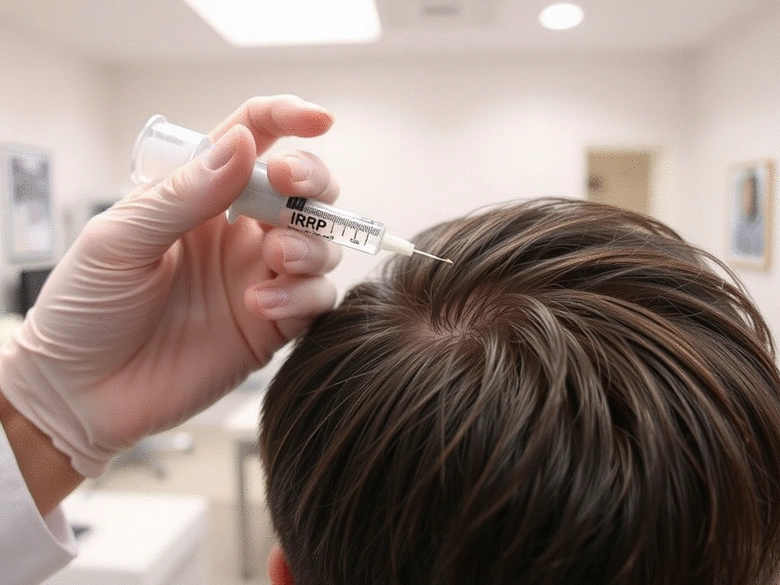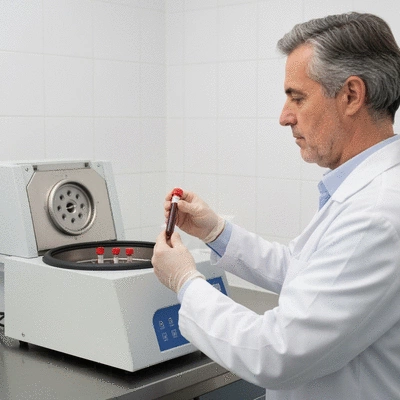1. Blood Draw
A small amount of blood is drawn from your arm, similar to a routine blood test.
As we delve into the world of hair restoration, it’s crucial to understand innovative treatments that can make a significant difference. PRP therapy, utilizing your body's own healing mechanisms, is gaining traction for its effectiveness in promoting hair regrowth. Here’s what you can learn about this cutting-edge solution!
Understanding the simple, three-step process of Platelet-Rich Plasma (PRP) therapy can demystify this innovative hair restoration treatment. Each step is designed to leverage your body's natural healing capabilities to stimulate hair growth.
A small amount of blood is drawn from your arm, similar to a routine blood test.
The blood is processed in a centrifuge to concentrate and separate the platelet-rich plasma.
The concentrated PRP is then injected into targeted areas of the scalp experiencing hair thinning.
Growth factors in PRP activate dormant follicles, leading to natural hair regrowth and increased density.
Have you heard about PRP therapy and its growing popularity in the world of hair restoration? As someone deeply invested in hair health, I’m excited to share insights into this innovative treatment. PRP stands for Platelet-Rich Plasma, and it's a cutting-edge approach that harnesses the healing power of your own blood to stimulate hair growth. Sounds interesting, right? Let’s explore this together!
At What Causes Hair Loss, we believe in providing our readers with evidence-based information. PRP therapy has become increasingly recognized for its effectiveness in promoting hair regrowth, especially for individuals dealing with various types of hair loss. By understanding what PRP is and how it works, you can make informed decisions about your hair care options.
Platelet-Rich Plasma (PRP) therapy involves extracting a small amount of your blood and processing it to concentrate the platelets. These platelets contain growth factors that can enhance healing and stimulate hair follicles. The process is minimally invasive and is typically performed in a clinical setting by trained professionals. Recent research highlights the efficacy of PRP therapy for hair regeneration, with studies showing its potential to activate dormant follicles and promote thicker hair growth. For instance, a publication in PMC NCBI provides an in-depth look at its mechanisms and clinical outcomes.
This therapy is appealing not just because it uses your body’s own resources, but also due to its potential to promote natural hair regrowth. Many patients report noticeable improvements in hair density and overall scalp health following treatment. Have you ever wondered if this could be the solution for your hair challenges?
There are several reasons why PRP therapy is becoming a go-to choice for hair restoration. First, it's based on natural healing processes, which makes it a safe option for many. Patients often appreciate that they are using their own biological material, reducing the risk of allergic reactions or complications. The growing body of scientific literature also supports its increasing adoption. For example, a comprehensive review in Frontiers in Medicine discusses the various applications and benefits of PRP therapy in dermatology, including hair restoration.
Furthermore, the growing body of research supporting PRP's effectiveness adds to its credibility. As a dermatologist, I have seen many patients who are enthusiastic about their results. For women experiencing hair loss, PRP therapy shows particular promise, as highlighted by articles in Dermatology Times, suggesting its potential as a valuable treatment option. If you’re considering hair restoration, it’s worth exploring PRP therapy as a viable option!
Understanding how PRP therapy stimulates hair growth can demystify the process for many people. This treatment works by activating dormant hair follicles and encouraging them to enter the growth phase more effectively. With the right knowledge, you can make informed choices about your hair health.
Have you ever considered PRP therapy for hair loss? We want to hear your opinions! Please share your thoughts below:
As we delve into the world of hair restoration, it's essential to understand the benefits of PRP therapy. This innovative treatment harnesses the healing power of your own blood, offering a range of advantages for those struggling with hair loss. By promoting natural hair regrowth, PRP therapy not only addresses thinning hair but also revitalizes hair follicles, enhancing overall scalp health.
Here are some key benefits of PRP therapy:
Ultimately, the effectiveness of PRP therapy lies in its ability to leverage your body’s natural healing processes, making it a promising option for many individuals facing hair loss challenges.
Here are some common questions about PRP therapy for hair restoration:
If you’re contemplating PRP therapy, it’s crucial to weigh the benefits against your unique situation. Consider how this treatment aligns with your personal hair health goals. Ask yourself: Is my hair loss progressing? Am I looking for non-invasive solutions? Are there specific outcomes I hope to achieve?
Before making a decision, I encourage you to explore the following:
In the journey of understanding hair restoration, being informed and proactive is vital. You deserve to feel confident in your decision-making process regarding PRP therapy!
Selecting the right clinic for your PRP treatment is a crucial step on your hair restoration journey. With so many options available, it can feel overwhelming. However, there are key factors to consider that can simplify your decision-making process.
By taking these steps, you can feel confident in your choice of clinic, ensuring you receive the best care for your hair health.
As you prepare for your consultation, it’s important to have a list of questions ready. This will help you gather all the necessary information to make an informed decision about PRP therapy. Here are some questions to consider asking:
Being well-prepared for your consultation will empower you to have an open and informative discussion, paving the way for a successful hair restoration journey. Remember, every question is a step towards taking control of your hair health!
Here is a quick recap of the important points discussed in the article:
At What Causes Hair Loss, we unravel the complexities of hair loss with science-backed insights, empowering you with dermatologist-reviewed guides and effective solutions for your hair health journey.
Dermatologist-Reviewed Insights


